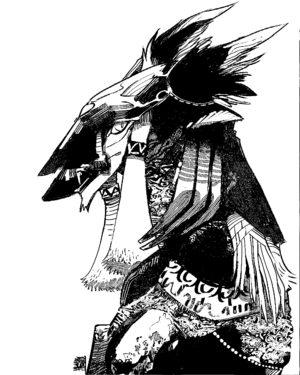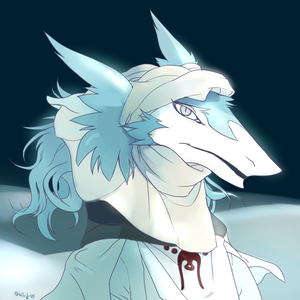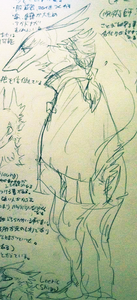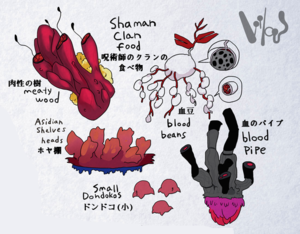Shamans: Difference between revisions
No edit summary |
No edit summary |
||
| (6 intermediate revisions by 2 users not shown) | |||
| Line 2: | Line 2: | ||
[[File:Shaman clan sergal.png|thumb|300px|Concept sketch of a sergal who belongs to Shaman clan.]] | [[File:Shaman clan sergal.png|thumb|300px|Concept sketch of a sergal who belongs to Shaman clan.]] | ||
'''Shamans''' (呪術師) are a type of class | '''Shamans''' ([[呪術師|呪術師]]) are a type of class, clan or occupation for [[Sergals|Sergals]]. | ||
It | It is mainly regarded as one out of the three [[Shigu#Clans|type of clan]] classifications In the early [[Shigu|Shigu]] stages, but also used to describe a somewhat common occupation which sergals can pursue. | ||
== '''Common features of shamans''' == | == '''Common features of shamans''' == | ||
| Line 10: | Line 10: | ||
<gallery heights="300" perrow="3" widths="300"> | <gallery heights="300" perrow="3" widths="300"> | ||
File:Shaman_sergal.png|A shaman sergal is going to the last small shrine for pilgrimage. He or she is maybe a mixed-breed person who comes from the Northeast. | File:Shaman_sergal.png|A shaman sergal is going to the last small shrine for pilgrimage. He or she is maybe a mixed-breed person who comes from the Northeast. | ||
</gallery> | </gallery> Shamans are one of the suitable occupations for [[Sergals|sergals]] as well as occupations which make use of their physical abilities like that of combatants and hunters. All sergals are suitable towards working with the surroundings of the supernatural culture, akin to that of shamans due to their deeply religious nature and superior sixth sense. They have a strong ability for shamanism as a racial nature, especially the more primitive sergals such as the uncivilized [[Northern_Sergals|Northern sergals]] which were highly predispositioned towards it. | ||
They | They perform shrine rituals, such as ceremonies, praying for rain, praying for the sun as well as exorcisms. Also, some of them will perform magic rituals, such as incantations, curses, fortunetelling and other miscellaneous praying. They undertake pilgrimages to dozens of small shrines around various places and corners of [[Planet_Tal|planet Tal]], in order for them to gather up their spiritual powers, which, they believe can make them able to perform both shrine and magic related rituals. Some of these small shrines are also found within dangerous [[Talyxian_Biomes|Talyxian biome]] areas as well. Notably, there is a small shrine within the [[Magoe_Forest|Magoe Forest]] where pilgrims undergo a high risk due to much dangerous wildlife presence and so on. | ||
== '''Shaman clan in pre-war [[Shigu|Shigu]]''' == | == '''Shaman clan in pre-war [[Shigu|Shigu]]''' == | ||
<gallery heights="300" perrow="3" widths="300"> | <gallery heights="300" perrow="3" widths="300"> | ||
File:Shaman-sketch.png|thumb|Concept sketch of a sergal who belongs to Shaman | File:Shaman-sketch.png|thumb|Concept sketch of a sergal who belongs to Shaman Clan | ||
</gallery> | </gallery> | ||
A clan in possession of the "[[Wolf_stamp_seal|wolf stamp seal]]" symbolizes their proof of spiritual practice, centering on shamans and mages which can manipulate names via the Art of Naming. | |||
They have a rich knowledge of wildlife and forest. Also, they show the highest aptitude for fluent speaking and | They have a rich knowledge of wildlife and the forest. Also, they show the highest aptitude for fluent speaking and have a higher vocabulary from the three clans in pre-war Shigu. Because handling words is an essential ability for them, they can use some civilized words to some extent. However, due to the few number of words available in the situation of previous Northern lands, even their own ways were still not too fluent. | ||
Comprehensively, they were the most civilized group | Comprehensively, they were the most civilized group amongst the Northern sergals before Northern lands became civilized. | ||
=== '''Lifestyle''' === | === '''Lifestyle''' === | ||
They also shared the worship of the [[Talyxian-Wolves|Talyxian-Wolves]], same as [[Braves|Brave]] Clans. | |||
They were generally staying in certain areas and rarely traveled from their village or group. | They were generally staying in certain areas and rarely traveled from their village or group. | ||
Most of the Northern [[Agudners|agudners]] were often living with their group and shaman sergals were able to trade with them in most of the cases. Thanks to this, they were able to get comparatively neat clothes and weapons, and their houses and villages were larger than other clans. | Most of the Northern [[Agudners|agudners]] were often living with their group and shaman sergals were able to trade with them in most of the cases. Thanks to this, they were able to get a hold of comparatively neat clothes and weapons, and their houses and villages were larger than other clans. | ||
=== '''Ability''' === | === '''Ability''' === | ||
While using their biological knowledge and their special technique "The Art of Naming", they can elucidate the true nature of things without | While using their biological knowledge and their special technique "The Art of Naming", they can elucidate the true nature of things without falling under [[Miasma|miasma]]'s influence. | ||
They use special items like [[Imagoi|imagoi]] liquid as a religious tradition, and they will induce a state of unified senses with the [[Talyxian_Biomes|Talyxian forest]] where it is filled with [[Miasma|miasma]]. This behavior is said to allow them to acquire a more mysterious power. | |||
Due to their mysterious, spiritual power and capability, they are believed to be a powerful and dependable member by the people who make allies of shamans. However, if they still do not possess a [[Wolf_stamp_seal|stamp seal]] and an unrefined ability to use words, they will always be recognized as "The Wordless" by mature, refined shamans. As such, the wordless will not be considered objectively capable individuals, because of their unstable ability and immature nature may potentially cause unexpected incidents and/or threats, rather than yield good results in their practice. | |||
=== Art of Naming === | |||
In prewar times, Northern Shigu lands, the people who can grasp the usage of words well were mostly limited to the ranks of experienced and mature shaman sergals. Even "having one's name" depended on a very special and limited opportunity. A rare occasion, if you will. Due to this, people seldom had names to call each other by, if there was no one around to "Give" them one. It is shamans who undertook this naming or christening process if you will. | |||
Experienced and mature shamans can give names to everything (Individuals, wildlife, various phenomenons) and can elucidate and figure out the true nature of things, without falling under the influence of Miasma. | |||
Thus, "the art of naming" has such an important and spiritual act. | |||
=== '''Diet''' === | === '''Diet''' === | ||
| Line 50: | Line 62: | ||
*'''Small [[Dondokos|Dondokos]]''' - A small [[Dondokos|dondoko]]. In addition to capturing them wild with a hidden trap, it is also possible to catch groups of infant [[Dondokos|dondokos]] in their bulb state and raise them as livestock for easier harvesting. This lead to husbandry methods to raise [[Dondokos|Dondokos]]. Pigs and cattle are also kept as livestock in this way. | *'''Small [[Dondokos|Dondokos]]''' - A small [[Dondokos|dondoko]]. In addition to capturing them wild with a hidden trap, it is also possible to catch groups of infant [[Dondokos|dondokos]] in their bulb state and raise them as livestock for easier harvesting. This lead to husbandry methods to raise [[Dondokos|Dondokos]]. Pigs and cattle are also kept as livestock in this way. | ||
*'''[[Ascidian_Shelves| | *'''[[Ascidian_Shelves|Ascidian Shelves]] heads''' - A body part from [[Ascidian_Shelves|Ascidian shelves]]. This creature is often used for shelving, desk tops and other uses after separating the lower half from the rest, applying salt and other treatments. This is an important export for Reono but people in the north use the upper half as a soft food. Since it is slightly hard, Sergals cut it and swallow the pieces whole. With their fondness for chewing food, [[Agudners|Agudners]] tend to pickle these for later eating. | ||
*'''Blood pipe''' - Found in the wilderness and shallow forests, this is a pipe-like organism that forms a fungal bed-like colony. Although not very nutritious, it is easy to grab and cut and then eaten by swallowing or chewing. | *'''Blood pipe''' - Found in the wilderness and shallow forests, this is a pipe-like organism that forms a fungal bed-like colony. Although not very nutritious, it is easy to grab and cut and then eaten by swallowing or chewing. | ||
| Line 58: | Line 70: | ||
*'''[[Imagoi|Imagoi]]''' - While not pictured here and not be food strictly, they tend to drink a liquid which can be intake from this substance on a daily basis as an intoxicating drink. Distilled versions of this are used in traditional religious ceremonies. | *'''[[Imagoi|Imagoi]]''' - While not pictured here and not be food strictly, they tend to drink a liquid which can be intake from this substance on a daily basis as an intoxicating drink. Distilled versions of this are used in traditional religious ceremonies. | ||
{{LinksEN}} | |||
[[Category: | [[Category:Sergals]] [[Category:Eltus]] [[Category:Occupations]][[Category:Societies]] | ||
Latest revision as of 15:23, 21 April 2020
Shamans (呪術師) are a type of class, clan or occupation for Sergals.
It is mainly regarded as one out of the three type of clan classifications In the early Shigu stages, but also used to describe a somewhat common occupation which sergals can pursue.
Common features of shamans
Shamans are one of the suitable occupations for sergals as well as occupations which make use of their physical abilities like that of combatants and hunters. All sergals are suitable towards working with the surroundings of the supernatural culture, akin to that of shamans due to their deeply religious nature and superior sixth sense. They have a strong ability for shamanism as a racial nature, especially the more primitive sergals such as the uncivilized Northern sergals which were highly predispositioned towards it.
They perform shrine rituals, such as ceremonies, praying for rain, praying for the sun as well as exorcisms. Also, some of them will perform magic rituals, such as incantations, curses, fortunetelling and other miscellaneous praying. They undertake pilgrimages to dozens of small shrines around various places and corners of planet Tal, in order for them to gather up their spiritual powers, which, they believe can make them able to perform both shrine and magic related rituals. Some of these small shrines are also found within dangerous Talyxian biome areas as well. Notably, there is a small shrine within the Magoe Forest where pilgrims undergo a high risk due to much dangerous wildlife presence and so on.
Shaman clan in pre-war Shigu
A clan in possession of the "wolf stamp seal" symbolizes their proof of spiritual practice, centering on shamans and mages which can manipulate names via the Art of Naming.
They have a rich knowledge of wildlife and the forest. Also, they show the highest aptitude for fluent speaking and have a higher vocabulary from the three clans in pre-war Shigu. Because handling words is an essential ability for them, they can use some civilized words to some extent. However, due to the few number of words available in the situation of previous Northern lands, even their own ways were still not too fluent.
Comprehensively, they were the most civilized group amongst the Northern sergals before Northern lands became civilized.
Lifestyle
They also shared the worship of the Talyxian-Wolves, same as Brave Clans.
They were generally staying in certain areas and rarely traveled from their village or group.
Most of the Northern agudners were often living with their group and shaman sergals were able to trade with them in most of the cases. Thanks to this, they were able to get a hold of comparatively neat clothes and weapons, and their houses and villages were larger than other clans.
Ability
While using their biological knowledge and their special technique "The Art of Naming", they can elucidate the true nature of things without falling under miasma's influence.
They use special items like imagoi liquid as a religious tradition, and they will induce a state of unified senses with the Talyxian forest where it is filled with miasma. This behavior is said to allow them to acquire a more mysterious power.
Due to their mysterious, spiritual power and capability, they are believed to be a powerful and dependable member by the people who make allies of shamans. However, if they still do not possess a stamp seal and an unrefined ability to use words, they will always be recognized as "The Wordless" by mature, refined shamans. As such, the wordless will not be considered objectively capable individuals, because of their unstable ability and immature nature may potentially cause unexpected incidents and/or threats, rather than yield good results in their practice.
Art of Naming
In prewar times, Northern Shigu lands, the people who can grasp the usage of words well were mostly limited to the ranks of experienced and mature shaman sergals. Even "having one's name" depended on a very special and limited opportunity. A rare occasion, if you will. Due to this, people seldom had names to call each other by, if there was no one around to "Give" them one. It is shamans who undertook this naming or christening process if you will.
Experienced and mature shamans can give names to everything (Individuals, wildlife, various phenomenons) and can elucidate and figure out the true nature of things, without falling under the influence of Miasma.
Thus, "the art of naming" has such an important and spiritual act.
Diet
They are excellent in handling danger, entering without fear into a resource-rich forest, and harvesting the meat plants with ease. They live mainly on bringing back seeds, hunting small animals, and domesticating others. This provides a wide variety of food selection:
- Meaty wood - A common flesh tree that grows in the forest areas of Tal. Although many trees near the entrance of the forest are hard-skinned, making them hard to eat, the deep forest trees have softer wood and plenty of nourishment available to eat just by cutting chunks out of them. They are the “forest’s viscera and sinew”. Although they are considered staple foods, harvesting these woods requires journeying deep into the dangerous forest.
- Blood beans - A type of vegetation found in Tal. Although it is called a bean, it grows in the ground of the forest to nearly the size of a potato. Wild species grow in large clusters, but because wild blood beans are dangerous to harvest, many are brought home and grown in round gardens for easier collection. Blood beans have a taste similar to that of internal organs. In addition, several blood bean varieties have been cultivated in Gold Ring.
- Small Dondokos - A small dondoko. In addition to capturing them wild with a hidden trap, it is also possible to catch groups of infant dondokos in their bulb state and raise them as livestock for easier harvesting. This lead to husbandry methods to raise Dondokos. Pigs and cattle are also kept as livestock in this way.
- Ascidian Shelves heads - A body part from Ascidian shelves. This creature is often used for shelving, desk tops and other uses after separating the lower half from the rest, applying salt and other treatments. This is an important export for Reono but people in the north use the upper half as a soft food. Since it is slightly hard, Sergals cut it and swallow the pieces whole. With their fondness for chewing food, Agudners tend to pickle these for later eating.
- Blood pipe - Found in the wilderness and shallow forests, this is a pipe-like organism that forms a fungal bed-like colony. Although not very nutritious, it is easy to grab and cut and then eaten by swallowing or chewing.
- Toad - Although not shown on the chart, it is a large toad-shaped Talyxian living mainly in the main Magoe Forest. The toads of Magoe will grow considerably larger than others found elsewhere. The toad is basically a trap-like creature that does not venture out of the forest and any attempts to capture without using a shaman are almost always unsuccessful.
- Imagoi - While not pictured here and not be food strictly, they tend to drink a liquid which can be intake from this substance on a daily basis as an intoxicating drink. Distilled versions of this are used in traditional religious ceremonies.
Useful Links
Start Vilous!
Enjoy the Stories!
Peek at the World!
Terms of Service



